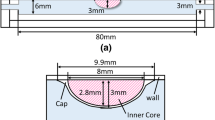Abstract
Interstitial flow through the subendothelial intima and media of an artery wall was simulated numerically to investigate the water flow distribution through fenestral pores which affects the wall shear stress on smooth muscle cells right beneath the internal elastic lamina (IEL). A two-dimensional analysis using the Brinkman model of porous media flow was performed. It was observed that the hydraulic permeability of the intimal layer should be much greater than that of the media in order to predict a reasonable magnitude for the pressure drop across the subendothelial intima and IEL (about 23 mostly at a 70 mm Hg luminal pressure). When Ki was set equal to the value in the media, this pressure drop was unrealistically high. Furthermore, the higher value of Ki produced a nearly uniform distribution of water flow through a simple array of fenestral pores all having the same diameters (1.2 μm), whereas when Ki was set at the value in the media, the flow distribution through fenestral pores was highly nonuniform and nonphysiologic. A deformable intima model predicted a nonuniform flow distribution at high pressure (180 mm Hg). Damage to the IEL was simulated by introducing a large fenestral pore (up to 17.8 μm) into the array. A dramatic increase in flow through the large pore was observed implying an altered fluid mechanical environment on the smooth muscle cells near the large pore which has implications for intimal hyperplasia and atherosclerosis. The model also predicted that the fluid shear stress on the bottom surface of an endothelial cell is on the order of 10 dyne/cm2 a level which can affect cell function. © 2001 Biomedical Engineering Society.
PAC01: 8719Tt, 8380Lz, 8716Uv, 8719Ff
Similar content being viewed by others
References
Baldwin, A. L., L. M. Wilson, and B. R. Simon. Effect of pressure on hydraulic conductance. Arterioscler. Thromb.12:163–171, 1992.
Brinkman, H. C.A calculation of the viscous force exerted by a flowing fluid on a dense swarm of particles. Appl. Sci. Res.A1:27–34, 1947.
Friedrich, R., and N. Rudraiah. Similar solutions of Brinkman equations for a two-dimensional plane jet in a porous medium. Trans. ASME J. Fluid. Eng.105:474–478, 1983.
Huang, Y., K. M. Jan, D. Rumschitzki, and S. Weinbaum. Structural changes in rat aortic intima due to transmural pressure. Trans. ASME J. Biomech. Eng.120:476–483, 1998.
Huang, Y., D. Rumschitzki, S. Chen, and S. Weinbaum. A fiber matrix model for the growth of macromolecular leakage spots in the arterial intima. Trans. ASME J. Biomech. Eng.116:430–445, 1994.
Huang, Y., D. Rumschitzki, S. Chien, and S. Weinbaum. A fiber matrix model for the filtration through fenestral pores in a compressible arterial intima. Am. J. Physiol.272:H2023-H2039, 1997.
Huang, Z. J., and J. M. Tarbell. Numerical simulation of mass transfer in porous media of blood vessel walls. Am. J. Physiol.273:H464-H477, 1997.
Lever, M. J., and N. Sharifi. The effects of transmural pressure and perfusate albumin concentration on the hydraulic conductivity of the isolated rabbit common carotid artery. J. Physiol. (London)387:68P, 1987.
Lipowsky, H. Flow Dependent Regulation of Vascular Function (Shear Stress in the Circulation). New York: Oxford University Press, 1995, pp. 28–45.
Roach, M. R., and S. H. Song. Arterial elastin as seen with scanning electron microscopy. Scanning Microsc.2:993–1004, 1988.
Sims, F. H., X. Chen, and J. B. Gavin. The importance of a substantial elastic lamina subjacent to the endothelium in limiting the progression of atherosclerotic changes. Histopathology23:307–317, 1993.
Tada, S., and J. M. Tarbell. Interstitial flow through the internal elastic lamina affects shear stress on smooth muscle cells in the artery wall. Am. J. Physiol.278:H1589-H1597, 2000.
Tarbell, J. M., L. Demaio, and M. M. Zaw. Effect of pressure on hydraulic conductivity of endothelial monolayers: Role of endothelial cleft shear stress. J. Appl. Physiol.87:241–268, 1999.
Tedgui, A., and M. J. Lever. Filtration through damaged and undamaged rabbit thoracic aorta. Am. J. Physiol.247:H784-H791, 1984.
Wang, D. M., and J. M. Tarbell. Modeling interstitial flow in an artery wall allows estimation of wall shear stress on smooth muscle cells. Trans. ASME J. Biomech. Eng.117:358–363, 1995.
Wight, T. N., and V. C. Hascall. Proteoglycans in primate arteries. III. Characterization of the proteoglycans synthesized by arterial smooth muscle cells in culture. J. Cell Biol.96:167–176, 1983.
Wong, L. C. Y., and B. L. Langille. Developmental remodeling of the internal elastic lamina of rabbit arteries. Circ. Res.78:799–805, 1996.
Yuan, F., S. Chien, and S. Weinbaum. A new view of convective-diffusive transport processes in the arterial intima. Trans. ASME J. Biomech. Eng.113:314–329, 1991.
Author information
Authors and Affiliations
Rights and permissions
About this article
Cite this article
Tada, S., Tarbell, J.M. Fenestral Pore Size in the Internal Elastic Lamina Affects Transmural Flow Distribution in the Artery Wall. Annals of Biomedical Engineering 29, 456–466 (2001). https://doi.org/10.1114/1.1376410
Issue Date:
DOI: https://doi.org/10.1114/1.1376410




